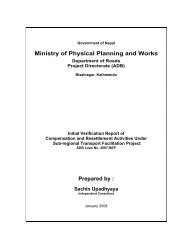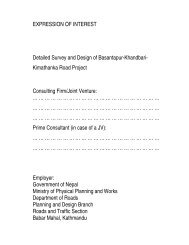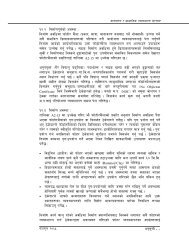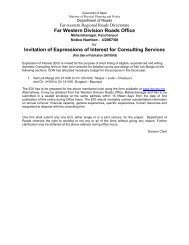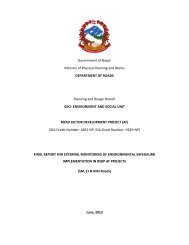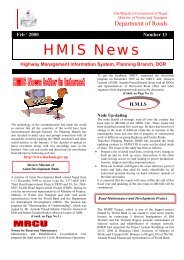Environmental & Social Management Framework - About ...
Environmental & Social Management Framework - About ...
Environmental & Social Management Framework - About ...
You also want an ePaper? Increase the reach of your titles
YUMPU automatically turns print PDFs into web optimized ePapers that Google loves.
<strong>Environmental</strong> and <strong>Social</strong> <strong>Management</strong> <strong>Framework</strong>vulnerable communities. It will take the following categories of people intoparticular account:• Poorest of the poor, irrespective of class, cast, gender and ethnicity (basedon the local wealth ranking)• Women headed poor households• All Dalit and ethnic minorities/ indigenous groups as categorized by GoNbeing vulnerable• Community members who are less able to care themselves without family orother support• Landless, squatters and encroachers.8.3 Potential Vulnerable Communities in NepalIn the context of Nepal, vulnerable community means communities living in aremote location who are commonly landless, marginal farmers living belowsubsistence level and often ex-kamaias (bonded labourers). Moreover, thesegroups have no or limited access to public resources, and they almost neverparticipate in national planning, policy, and do not partake in decision makingprocesses or in development initiatives. As a result, their risk of falling below theincome poverty line is extraordinarily high.Formal and informal studies reveal that most of the Janajati, Adhibasi, Dalit andgenerally women fall under the category of vulnerable persons in Nepal. This isalso reflected in the Government’s Tenth Plan (see Chapter 3) which recognizeswomen, disabled, ethnic minorities and Dalit groups as the prominent poor andmarginalized groups. Women in all social groups and regions have been provenas more disadvantaged than their male counterpart and even among women,widows, separated divorced and women headed households are particularlydisadvantaged.In Nepal, the term indigenous people (Adhibasi) equates with ethnic groups(Janajati). The constitution of Nepal recognizes indigenous people as Janajatis orNationalities. The National Foundation for Improving the Living Standard ofAdhibasi/Janajati has defined indigenous people as ‘those ethnic groups orcommunities who have their own mother tongue and traditional customs, distinctcultural identity, distinct social structure and written or oral history of their own’.Following this definition, the same source identified 59 groups in Nepal as ethnicindigenous groups or nationalities.Table 8.1: Classification of Vulnerable Groups/Janajati in NepalEndangered Bankariya, Kusunda, Kushbadia, Raute, Surel, Hayu, Raji, Kisan,GroupsLepcha, Meche (10 groups)Highly Marginalized Santhal, Jhangad, Chepang, Thami, Majhi, Bote, DhanukGroups(Rajbansi), Lhomi (Singsawa), Thudamba, Siyar (Chumba),Baramu, Danuwar (12 groups)Marginalized Sunuwar, Tharu, Tamang, Bhujel, Kumal, Rajbansi (Koch),GroupsGangai, Dhimal, Bhote, Darai, Tajpuria, Pahari, Dhokpya(Topkegola), Dolpo, Free, Magal, Larke (Nupriba), Lhopa, Dura,Walung (20 groups)Disadvantaged Jirel, Tangbe (Tangbetani), Hyolmo, Limbu, Yakkha, Rai,GroupsChhantyal, Magar, Chhairotan, Tingaunle Thakali, Bahragaunle,Byansi, Gurung, Marphali Thakali, Sherpa. (15 groups)Advanced Groups Newar, Thakali (2 groups)[Source: National Foundation for Indigenous Nationalities (NEFIN) 2004]Chapter 8-2 April 2007



![j:6 ]zg cfof ]hgf](https://img.yumpu.com/51286794/1/190x245/j6-zg-cfof-hgf.jpg?quality=85)

![x'nfsL /fhdfu { cfof ]hgf](https://img.yumpu.com/50581959/1/190x245/xnfsl-fhdfu-cfof-hgf.jpg?quality=85)
